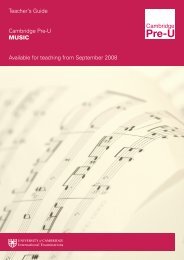Cambridge Pre-U Syllabus - Cambridge International Examinations
Cambridge Pre-U Syllabus - Cambridge International Examinations
Cambridge Pre-U Syllabus - Cambridge International Examinations
You also want an ePaper? Increase the reach of your titles
YUMPU automatically turns print PDFs into web optimized ePapers that Google loves.
34<br />
4. THE LIFE OF PLANTS<br />
<strong>Cambridge</strong> <strong>Pre</strong>-U Draft<br />
Plants provide us with the material to study many biological principles. We ignore them at our peril as they<br />
are the foundation of almost all food chains and provide us, directly or indirectly, with most of our food and<br />
many economically important products. This section explores several aspects of their physiology – from their<br />
highly adaptable transport systems to the great variety of methods of reproduction and ultimate reliance on<br />
sunlight.<br />
These questions may be put to candidates to stimulate discussion and prompt and direct their own<br />
researches while covering Section 4.<br />
• How do plants transport materials?<br />
• How does water get to the top of a redwood tree that is over 110 m high?<br />
• Why are plants called producers?<br />
• Why do we neglect plants ‘at our peril’?<br />
• How do plants control themselves?<br />
• Why do some plants produce flowers, seeds and fruits?<br />
4.1 Transport in plants<br />
Content<br />
Transport of water in the xylem<br />
Transport of assimilates in the phloem<br />
Stomata – structure and function<br />
Learning outcomes<br />
Candidates should be able to:<br />
a) describe the passage of water through a dicotyledonous plant from soil to atmosphere<br />
b) describe the structure and function of the xylem of flowering plants and explain the relationship between<br />
its structure and functions<br />
c) explain the role of cohesion-tension in the transport of water in the xylem<br />
d) describe the structure and function of guard cells<br />
e) explain the mechanism of opening and closing of stomata<br />
f) explain the effect of vascular wilt diseases of plants (including Panama disease of bananas)<br />
g) describe the structure and function of phloem tissue and explain the relationship between its structure<br />
and function<br />
h) explain mass flow in phloem<br />
Practical learning outcomes<br />
Candidates should be able to:<br />
i) explain the relationship between structure and function of xylem and phloem using histological<br />
specimens from plant transport systems including prepared slides and electronmicrographs

















